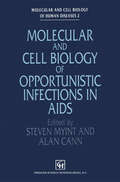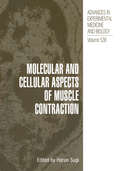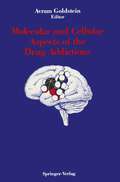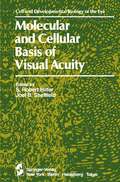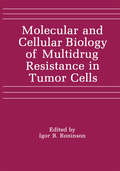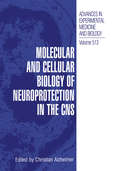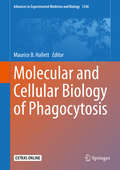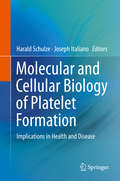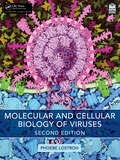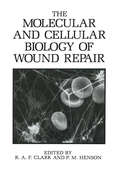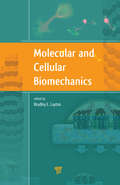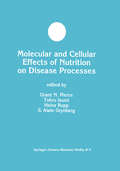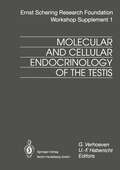- Table View
- List View
Molecular and Cell Biology of Cancer: When Cells Break the Rules and Hijack Their Own Planet (Learning Materials in Biosciences)
by Rita Fior Rita ZilhãoThis textbook takes you on a journey to the basic concepts of cancer biology. It combines developmental, evolutionary and cell biology perspectives, to then wrap-up with an integrated clinical approach.The book starts with an introductory chapter, looking at cancer in a nut shell. The subsequent chapters are detailed and the idea of cancer as a mass of somatic cells undergoing a micro-evolutionary Darwinian process is explored. Further, the main Hanahan and Weinberg “Hallmarks of Cancer” are revisited. In most chapters, the fundamental experiments that led to key concepts, connecting basic biology and biomedicine are highlighted. In the book’s closing section all of these concepts are integrated in clinical studies, where molecular diagnosis as well as the various classical and modern therapeutic strategies are addressed. The book is written in an easy-to-read language, like a one-on-one conversation between the writer and the reader, without compromising the scientific accuracy. Therefore, this book is suited not only for advanced undergraduates and master students but also for patients or curious lay people looking for a further understanding of this shattering disease
Molecular and Cell Biology of Human Gene Therapeutics (Molecular and Cell Biology of Human Diseases Series #20)
by G. Dicksonadvanced metastatic disease of solid tumors, dictates that each tumor mass, indeed each individual metastasis, will have a unique antigen and cytokine environment and hence unique response to immune modu lation. A differential response to immunotherapy is thus inevitable. 4. Many of the human trials described are not randomized and report survival or response against historical controls. Most tumors described are immunogenic human tumors: renal cell cancer and melanoma are most common. In order to avoid the well-described inter-patient vari ation and rare incidence of spontaneous response among patient samples as well as selection bias and changes in practice over time, randomized trials are required. 5. Immunological treatment is unlike conventional chemotherapy in its endpoint. Most chemotherapeutic regimes require a complete response or a good partial response for cure or good palliation. There are now many cases where immunotherapy has provided long-term palliation without massive tumor reduction. Immunity may be stimulated to a degree which holds tumorigenicity in check and most importantly, pro vides good palliation for the patient in a manner that differs essentially from chemotherapy.
Molecular and Cell Biology of Muscular Dystrophy (Molecular and Cell Biology of Human Diseases Series)
by T. PartridgeMolecular and Cell Biology of Muscular Dystrophy gives a series of accounts of various aspects of the remarkable breakthrough which has been achieved in our understanding of the Duchenne/Becker muscular dystrophies and of the consequences and ramifications of this breakthrough.
Molecular and Cell Biology of Neuropsychiatric Diseases (Molecular and Cell Biology of Human Diseases Series)
by F. Owen R. ItzhakiMolecular and Cell Biology of Opportunistic Infections in AIDS (Molecular and Cell Biology of Human Diseases Series)
by S. Myint A. CannHuman immunodeficiency virus and AIDS have received much attention in the last decade. As the major cause of death in young adults, this concern is merited. AIDS has also ushered onto the clinical agenda a number of unusual and interesting pathogens. These have had considerably less attention than the virus itself, but are arguably as important. This book attempts to put into one volume a state of the art review of the basic biology of these opportunistic organisms. When compiling this book, the perceived difficulty was deciding how to restrict the number of chapters, as there is a large number of opportunistic organisms. It soon became clear, however, that the chapters would select themselves, as the work on many of these organisms was still in its infancy. We can be criticized for including Salmonella, which is not thought to be an opportunistic infection, and excluding Cryptococcus. Our defence is that the former has an interesting relationship with HIV and the latter is one of those organisms for which the basic biology is still in its early stages. The authors are all active researchers in their respective fields and we are grateful that they managed to review their subjects in the short turn-around time required for a book such as this not to be needlessly outdated on publication. We hope that, if nothing else, this book stimulates interest and more research on these agents: perhaps, in future editions, there will be much more to describe on their molecular biology.
Molecular and Cell Biology of Pancreas Development, Function and Regeneration (Advances in Anatomy, Embryology and Cell Biology #239)
by Maria L. GolsonThis book reviews recent advances in pancreatic endocrine and exocrine tissue development, function and regeneration. It provides a comprehensive overview on different aspects of beta-cell biology, including heterogeneity of function and gene expression and function, epigenetics, RNA and protein expression contributions to beta-cell specification and cell-fate maintenance. Furthermore, it covers recent progress in differentiating functional islets in vivo, environmental impacts on beta-cell development and function, and communications between various islet endocrine cells and how they contribute to the regulation of blood glucose homeostasis.The book provides a comprehensive resource for understanding the various compartments of the pancreas and is aimed at pancreas, beta-cell biology, and diabetes researchers.
Molecular and Cell Biology of Sexually Transmitted Diseases (Molecular and Cell Biology of Human Diseases Series)
by D. J. Wright L. C. ArchardMolecular and Cell Biology of Human Diseases reviews the status of research on a range of sexually transmitted diseases whose incidence has paralleled the increase in HIV infection and examines the ways in which new methods are influencing current practice and are likely to shape future management.
Molecular and Cellular Aspects of Muscle Contraction (Advances in Experimental Medicine and Biology #538)
by Haruo SugiThis volume presents the proceedings of a muscle symposium, which was supported by the grant from the Fujihara Foundation of Science to be held as the Fourth Fujihara Seminar on October 28 -November 1, 2002, at Hakone, Japan. The Fujihara Seminar covers all fields of natural science, while only one proposal is granted every year. It is therefore a great honor for me to be able to organize this meeting. Before this symposium, I have organized muscle symposia five times, and published the proceedings: " Cross-bridge Mechanism in Muscle Contraction (University of Tokyo Press, 1978), "Contractile Mechanisms in Muscle" (plenum, 1984); "Molecular Mechanisms of Muscle Contraction" (plenum, 1988); "Mechanism of MyofIlament Sliding in Muscle contraction" (plenum, 1993); "Mechanisms of Work Production and Work Absorption in Muscle" (plenum, 1998). As with these proceedings, this volume contains records of discussions made not only after each presentation but also during the periods of General Discussion, in order that general readers may properly evaluate each presentation and the up-to-date situation of this research field. It was my great pleasure to have Dr. Hugh Huxley, a principal discoverer of the sliding fIlament mechanism in muscle contraction, in this meeting. On my request, Dr. Huxley kindly gave a special lecture on his monumental discovery of myofIlament-lattice structure by X-ray diffraction of living skeletal muscle. I hope general readers to learn how a breakthrough in a specific research field can be achieved.
Molecular and Cellular Aspects of Periimplantation Processes (Serono Symposia USA)
by S. K. DeyThis volume contains the proceedings of the Symposium on Molecular and Cellular Aspects of Periimplantation Processes, held July 15 - 18, 1994, in Boston, Massachusetts. Despite considerable research, the molecular and cellular bases of embryo-uterine interactions are still poorly understood. The papers included in this volume address recent advances in several areas in the field of implantation, including uterine receptivity, hormonal regulation, cell-cell interaction, growth factors/cytokines, immunobiology, and trophoblast invasion.
Molecular and Cellular Aspects of the Drug Addictions
by Avram GoldsteinIn 1970 I gave up the chairmanship of the Department of Pharmacology at Stanford University Schoel of Medicine to devote full time to basic and clinical research on problems of drug addiction. In 1971 I developed the method of radioligand binding that led to the important characterization of opioid receptors in several laboratories. The extraordinary specificity of these receptors for morphine and related opiates suggested the likelihood that there were naturally occurring morphine-like molecules in the brain and other tissues. The systematic search for these molecules culminated in 1979 in the discovery, by my group, ofthe dynorphin peptides-one of the three families of opioid peptides, the first of which (the enkephalin family) had been discovered in Aberdeen, Scotland, in 1975. I also became involved in clinical research on the pharmacologic treatment of heroin addicts, for which I established the first large methadone mainte nance treatment program in California. My basic and clinical research experience convinced me that an institution encompassing laboratory research, studies on normal human volunteers, and treatment research, under a single roof, could expedite progress in understanding the drug addictions. That concept was transformed into reality by the founding, in 1974, of the Addiction Research Foundation of Palo Alto, California. The funds for construction of a laboratory were provided by a generous grant from the Drug Abuse Council (a consortium of several foundations), the president of which was Thomas L. Bryant.
Molecular and Cellular Basis of Inflammation (Current Inflammation Research)
by Charles N. Serhan Peter A. WardThe study of inflammation has captured the interest of scholars since the earliest recorded history. Symbols identifying the cardinal signs of inflammation were uncovered in both Sanskrit and hieroglyphics (1). Since complete apprecia tion of the inflammatory process is underscored by the need for knowledge at both the cellular and molecular levels, academic inquiry in the area of inflammation has led, in many respects, the foray of current biomedical research. Molecular and Cellular Basis of Inflammation represents research from the cutting edge in the broad view of inflammation. The chapters are written by experts with a multidisciplinary approach to the study of inflammatory and cellular processes, and thus include contributions form the fields of molecular biology, biochemistry, pharmacology, immunology, and pathobiology. Molecular and Cellular Basis of Inflammation was first conceived during a mini symposium sponsored by the American Society for Investigative Pathology held at FASEB in 1995 entitled "The Role of Reactive Lipids, Oxygen and Nitro gen Metabolites in Inflammation," at which several of the contributing authors delivered lectures. This present, much-extended volume includes leading-front descriptions of both protein and lipid mediators. The chapter devoted to the comple ment cascade by Ward and colleagues, as well as Chapters 3-7 and 13, provide up to-date descriptions of the biosynthesis, molecular biology, chemistry, and actions of both protein and lipid mediators.
The Molecular and Cellular Basis of Neurodegenerative Diseases: Underlying Mechanisms
by Michael S. WolfeThe Molecular and Cellular Basis of Neurodegenerative Diseases: Underlying Mechanisms presents the pathology, genetics, biochemistry and cell biology of the major human neurodegenerative diseases, including Alzheimer's, Parkinson's, frontotemporal dementia, ALS, Huntington's, and prion diseases. Edited and authored by internationally recognized leaders in the field, the book's chapters explore their pathogenic commonalities and differences, also including discussions of animal models and prospects for therapeutics. Diseases are presented first, with common mechanisms later. Individual chapters discuss each major neurodegenerative disease, integrating this information to offer multiple molecular and cellular mechanisms that diseases may have in common. This book provides readers with a timely update on this rapidly advancing area of investigation, presenting an invaluable resource for researchers in the field. - Covers the spectrum of neurodegenerative diseases and their complex genetic, pathological, biochemical and cellular features - Focuses on leading hypotheses regarding the biochemical and cellular dysfunctions that cause neurodegeneration - Details features, advantages and limitations of animal models, as well as prospects for therapeutic development - Authored by internationally recognized leaders in the field - Includes illustrations that help clarify and consolidate complex concepts
Molecular and Cellular Basis of Visual Acuity (The Cell and Developmental Biology of the Eye)
by S. R. Hilfer Joel SheffieldThe Seventh Symposium on Ocular and Visual Development was held in October, 1982. The aim of the meeting was to develop a broad perspective on visual acuity. The subject was discussed initially in terms of molecular events of photoreception, and the metabolism of the photoreceptor ele ments. Subsequent papers presented the development and complexity of the neurocircuitry and transmitter systems in the retina that process the visual information prior to transfer to the brain. The meeting concluded with a series of papers on behavioral and physiological methods of mea surement of visual acuity in humans, particularly young children. This volume arose from the papers presented at the meeting. We feel that the juxtaposition of research of broadly differing methodologies will be stim ulating, rather than daunting, and will generate an enhanced understand ing of this complex subject. We are indebted to our colleagues: Dr. M. Mote from Temple University, and Drs. J. Siegfried, P. Dayhaw-Barker, and L. Press from the Pennsylvania College of Optometry for their expertise and assistance in the organization of the meeting; to the speakers for their presentations and contributions to this volume; and to the reviewers of the manuscripts for their helpful comments. This symposium could not have been held without the generous support of the Temple University College of Arts and Sciences and the Pennsyl vania College of Optometry. We also thank Merck, Sharp and Dohme, Inc. for their donation.
Molecular and Cellular Biology of Insulin-like Growth Factors and Their Receptors
by Derek Leroith Mohan K. RaizadaAn essential element in the development and functional integrity of all organisms is intercellular communication. This is achieved by the secretion of soluble messenger molecules which subsequently interact with receptor-effector pathways in the responsive cells. Hormones are traditionally defined as chemical messengers synthesized by endocrine glands. Unlike hormones produced by endocrine glands, growth factors are hormone-related substances produced by many tissues and play an important role in controlling growth and development. While the exact physiological roles of growth factors have yet to be elucidated, they play important roles in the regulation of cellular proliferation and/or differentiation during ontogenesis, growth and differentiation. During recent years there has been a substantial increase in research related to peptide growth factors, their receptors, and modes of action. With the discovery and characterization of numerous growth factors, it became clear that these growth factors had multiple features in common with classic hormones as well as with oncogenes. Furthermore, there are distinct families of growth factors based either on structural or functional similarities.
Molecular and Cellular Biology of Multidrug Resistance in Tumor Cells
by Igor B. RoninsonThe ability of neoplastic cells to survive exposure to various chemotherapeutic drugs represents the main obstacle to successful cancer chemotherapy. This book deals with a particular type of resistance in tumor cells that represents a single but especially important aspect of the multifaceted problem of cancer drug resistance. This type of resistance, known as multidrug or pleiotropic drug resistance, is characterized by cross-resistance of cells to several different classes of cytotoxic drugs, including some of the most commonly used anticancer agents. Over the last several years, there has been a veritable explosion of genetic, biochemical, and clinical information on multidrug resistance, which followed the identification and cloning of the genes responsible for this phenotype and the isolation of monoclonal antibodies against P-glycoproteins, the products of these genes. Elucida tion of the molecular mechanism of multidrug resistance has led to the formulation of novel approaches to the prediction of tumor response to chemotherapeutic drugs and increasing the efficacy of cancer therapy. Analysis of the structure and function of P glycoproteins from multidrug-resistant mammalian cells has also established a prototype for a novel class of eukaryotic membrane proteins, which have now been associated with a variety of transport processes in different organisms. This book summarizes the results of molecular biological, pharmacological, bio chemical, cytogenetic, immunological, and pathological studies on multidrug resistance in mammalian cells. Most of the chapters deal at least to some extent with the structure and expression of P-glycoprotein and its role in multidrug resistance.
Molecular and Cellular Biology of Neuroprotection in the CNS (Advances in Experimental Medicine and Biology #513)
by Christian AlzheimerGiven the very limited capacity of regeneration in the brain, protecting neurons that are on the brink of death is a major challenge for basic and clinical neuroscience, with implications for a broad spectrum of acute and chronic neurological and psychiatric diseases. This book brings together leading experts from neurobiology, neurophysiology, neuropharmacology, neuroimmunology and clinical neuroscience to highlight the most recent milestones in this rapidly evolving field. The book will serve as a reference for both basic neuroscientists and clinicians interested in an authoritative update on the molecular and cellular biology of neuroprotection and its promises for new therapeutic strategies.
Molecular and Cellular Biology of Phagocytosis (Advances in Experimental Medicine and Biology #1246)
by Maurice B. HallettPhagocytosis is the engulfment of particulate matter by cells. It is a fundamental (and probably “primitive”) cell biological process which is important in single celled organisms such as amoeba; multicellular animals including coelenterates; and in higher animals. In humans and other mammals, specialised immune cells (phagocytes) utilise phagocytosis in their crucial role of engulfing and destroying infecting microbes. Yet, surprisingly, the biophysics and biochemistry underlying the process has only become clear recently with the advent of genetic manipulation and advances in single cell imaging. In this volume, the aim is to bring together recent fundamental advances that give a clear picture of the underlying mechanism involved in phagocytosis. Not only is this an important topic in its own right, but a full understanding of the process will have a potential impact on human medicine, since as antibiotics become less effective in fight infection, researchers are looking at alternative approaches, including enhancing the “natural” immunity brought about by immune phagocytes.The aim is to provide a comprehensive volume on the topic, with separate chapters on identified recent advances, each written by the major contributors in each area. In addition, the volume will attempt to give a wider overview than is often the case in single author reviews, with an emphasis here on the cell biological understanding of phagocytosis using biophysical approaches alongside the biochemical and imaging approaches.
Molecular and Cellular Biology of Platelet Formation: Implications in Health and Disease
by Harald Schulze Joseph ItalianoThis book gives a comprehensive insight into platelet biogenesis, platelet signal transduction, involvement of platelets in disease, the use of diverse animal models for platelet research and future perspectives in regard to platelet production and gene therapy. Being written by international experts, the book is a concise state-of-the art work in the field of platelet biogenesis, biology and research. It represents an indispensable tool for research scientists in biomedicine, vascular biology, hematopoiesis and hemostasis and specifically for scientists in platelet research, as well as for clinicians in the field of hematology and transfusion medicine.
Molecular and Cellular Biology of Prostate Cancer (Advances In Experimental Medicine And Biology Ser.)
by James P. Karr Donald S. Coffey Roy G. Smith Donald J. TindallThese proceedings of the 5th Prouts Neck Meeting on Prostate Cancer, held in October, 1989, highlight the many advances in the understanding of prostatic growth and function at the cellular and molecular levels which have been registered since the first Prouts Neck Meeting in 1985, a meeting which also focused on the then current concepts and basic approaches to understanding prostate cancer. Inter vening Prouts Neck Meetings in 1986, 1987 and 1988 were devoted to treatment, image cytometry and clinical markers. As before, the Prouts Neck tradition of bringing together an international, multidiscipli nary group of experts for 3 days to exchange ideas and new data, in the relaxed atmosphere of an old iun on the scenic Maine coast, proved to be an ideal combination for a highly successful conference. Accordingly, the Organ System Program of the National Cancer Institute plans to use the Prouts Neck model for future conferences on other solid tumors (bladder in 1990 and kidney in 1991) and will return to the prostate in 1992. A new dimension was added to the current program through the inclusion of a poster session to recognize the research of pre-and postdoctoral investigators. The posters were judged by Drs. Collette Freeman, Frank French, Shutsung Liao, Robert Matusik and Henry Sun. The three winners, in alphabeti cal order, were John Fabian, Robert Getzenberg and Ming Fong-Lin.
Molecular and Cellular Biology of Viruses
by Phoebe LostrohThis fully revised second edition of Molecular and Cellular Biology of Viruses leads students on an exploration of viruses by supporting engaging and interactive learning. All the major classes of viruses are covered, with separate chapters for their replication and expression strategies, and chapters for mechanisms such as attachment that are independent of the virus genome type. Specific cases drawn from primary literature foster student engagement. End-of-chapter questions focus on analysis and interpretation with answers being given at the back of the book. Examples come from the most-studied and medically important viruses such as SARS-CoV-2, HIV, and influenza. Plant viruses and bacteriophages are also included. There are chapters on the overall effect of viral infection on the host cell. Coverage of the immune system is focused on the interplay between host defenses and viruses, with a separate chapter on medical applications such as antiviral drugs and vaccine development. The final chapter is on virus diversity and evolution, incorporating contemporary insights from metagenomic research. The second edition has updated suggestions for primary literature to discuss along with each chapter. New to this second edition, a supplementary chapter, freely available for download, looks at how virology intersects with public health, and uses the COVID-19 pandemic as a notable example.Key Features Readable but rigorous coverage of the molecular and cellular biology of viruses Molecular mechanisms of all major groups, including plant viruses and bacteriophages, illustrated by example Host-pathogen interactions at the cellular and molecular level emphasized throughout Medical implications and consequences included Quality illustrations available to instructors New to this second edition, interactive quiz questions hosted online
Molecular and Cellular Biology of Viruses
by Phoebe LostrohThis fully revised second edition of Molecular and Cellular Biology of Viruses leads students on an exploration of viruses by supporting engaging and interactive learning. All the major classes of viruses are covered, with separate chapters for their replication and expression strategies, and chapters for mechanisms such as attachment that are independent of the virus genome type. Specific cases drawn from primary literature foster student engagement. End-of-chapter questions focus on analysis and interpretation with answers being given at the back of the book. Examples come from the most-studied and medically important viruses such as SARS-CoV-2, HIV, and influenza. Plant viruses and bacteriophages are also included. There are chapters on the overall effect of viral infection on the host cell. Coverage of the immune system is focused on the interplay between host defenses and viruses, with a separate chapter on medical applications such as antiviral drugs and vaccine development. The final chapter is on virus diversity and evolution, incorporating contemporary insights from metagenomic research. The second edition has updated suggestions for primary literature to discuss along with each chapter. New to this second edition, a supplementary chapter, freely available for download, looks at how virology intersects with public health, and uses the COVID-19 pandemic as a notable example.Key Features Readable but rigorous coverage of the molecular and cellular biology of viruses Molecular mechanisms of all major groups, including plant viruses and bacteriophages, illustrated by example Host-pathogen interactions at the cellular and molecular level emphasized throughout Medical implications and consequences included Quality illustrations available to instructors New to this second edition, interactive quiz questions hosted online
The Molecular and Cellular Biology of Wound Repair
by R.A.F. Clark P.M. HensonEditing a book of this nature was a simultaneously exhilarating and frightening experience. It was exhilarating to draw from cell biologists, biochemists, and molecular biologists, as well as those dermatologists, pathologists, and pul monologists who are cell biologists at heart, to author chapters. At the same time, it was frightening to ask such busy investigators to devote their precious time to writing chapters that summarize not just their own endeavors but their entire area of expertise. However, the authors assuaged our fears by enthusi astically accepting the proposal to write on specific topics despite the time burden, and to update and willingly accept our editorial comments. In the editors' view, the authors have captured the important scientific data in their respective fields, have organized the data into an understandable outline, and have applied the information to elucidating wound repair processes. The explosion of new, important discoveries in the field of wound repair and related areas as our book was developing has been very unsettling. This observation predicts obsolescence. In response to this possibility, the authors and the editors have attempted to build fundamental concepts upon existing data. Hopefully, these concepts will help provoke further experimentation to unravel the complex, interwoven processes of wound repair. The book has been organized into three parts: Inflammation, Granulation Tissue Formation, and Extracellular Matrix Production and Remodeling.
Molecular and Cellular Biomechanics
by Bradley LaytonThis book bridges the gap between life sciences and physical sciences by providing several perspectives on cellular and molecular mechanics on a fundamental level. It begins with a general introduction to the scales and terms that are used in the field of cellular and molecular biomechanics and then moves from the molecular scale to the tissue scal
Molecular and Cellular Effects of Nutrition on Disease Processes (Developments in Molecular and Cellular Biochemistry #26)
by Grant N. Pierce Heinz Rupp Tohru Izumi Alain GrynbergMolecular and Cellular Endocrinology of the Testis (Ernst Schering Foundation Symposium Proceedings #1)
by U. F. Habenicht G. VerhoevenThe European Workshops on Molecular and Cellular Endocrinology of the Testis have become by now a well-established tradition. Thanks to their special format, the quality of the main lectures and miniposters, and the vivid discussions, they enjoy the ever-increasing interest and active participation of all European scientists working in the field. Moreover, since the very beginning they have attracted investigators from all over the world. The most recent "Testis Workshop" was held in De Panne, Belgium, from 27-3\ March, 1994. As always, the frame work of the workshop was provided by a series of lectures delivered by a panel of internationally recognized authorities. These lectures are ga thered in the present volume of the Ernst Schering Foundation Work shop series. Together with the Miniposter book they constitute an excel lent written account of the Proceedings of the 8th European Testis Workshop. The testis undoubtedly represents one of the most complex and in triguing tissues in the body. Both its endocrine function, the secretion of male sex hormones, and its exocrine role, the production of mature spermatozoa, continue to raise startling questions to clinicians, physi ologists, endocrinologists, and scientists involved in fundamental re search. Few organs maintain and support a differentiation process as complicated as spermatogenesis; few tissues continually display both mitotic and meiotic cell cyles in such a stringently controlled fashion or a comparable need for coordinated endocrine and local control.




